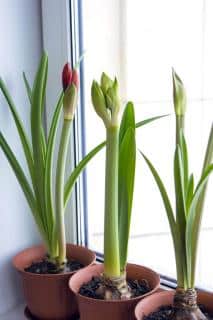

Amaryllis is a bulbous plant, magnificent when it blooms in fall, or winter indoors.
Summary of Amaryllis facts
Name – Hippeastrum
Family – Amaryllidaceae
Type – bulbous, indoor flower
Height – 12 to 24 inches (30 to 60 cm)
Exposure – full sun
Soil – soil mix, well-drained
Climate – rather warm if outdoors – Flowering – Winter
These tips on how to care for amaryllis should help you get dazzling flowers.
Amaryllis is normally grown during the fall and winter seasons, and fall is when bulbs must be prepared and planted in the ground.

Remember to plant it in special flower plant soil mix, or re-potting soil mix.
Plant the amaryllis bulb so that roots touch the bottom and the cut stem just sticks out from the soil.
If you’ve already got an amaryllis and you wish to make it bloom again, check our page that deals with this specifically:
Growing amaryllis outdoors in most of Europe isn’t possible because it isn’t hardy: winters are often too cold for it to survive.
But if the climate is mild enough, that is, winter is mild enough, plant your bulbs in spring when the last frosts are past, in a mix of soil mix and garden soil.
At the end of the blooming season, once the leaves have yellowed and dried, you can dig out the bulbs and plant them again in the following spring, unless winter temperatures in your area never dip below 55°F (12°C).
To keep the bulbs over winter, choose a rather dry, ventilated and dark place.

Reduce then stop watering once the leaves start wilting.
Place the bulbs in a cool, ventilated spot and let the leaves fall off on their own.
In January the bulb will enter its growth phase again.
Once your amaryllis has finished blooming, whatever happens, do not cut the leaves off, quite the opposite…
After flowering, it still is possible to get the flower to bloom again the following year. Indeed, if correctly kept, amaryllis bulbs will bloom again year after year.
A dormant phase is required from the end of the blooming season until the following fall. It must last at least two months and must take place in a rather cool and dry place.
After flowering, you must keep watering the plant when the soil is dry, adding ½ dose of flower plant fertilizer every two weeks. In fact, it is after the blooming and before the withering that the plant stocks up on nutrients for the next blooming cycle.

They are very well-known for their dazzling flowers, abundant and brightly colored.
Although they usually bloom in spring, amaryllis can be found in flower shops as early as Christmas time.
You must know that for them to bloom in that season, the bulbs were forced: it isn’t their normal blooming period.
This must not stop you from preciously keeping your bulbs after the blooming because it’s possible for you to make those amaryllis bloom again!
Amaryllis will perfectly complement green plants and shrubs in your garden flower beds, on your terrace or indoors.
©akuptsova